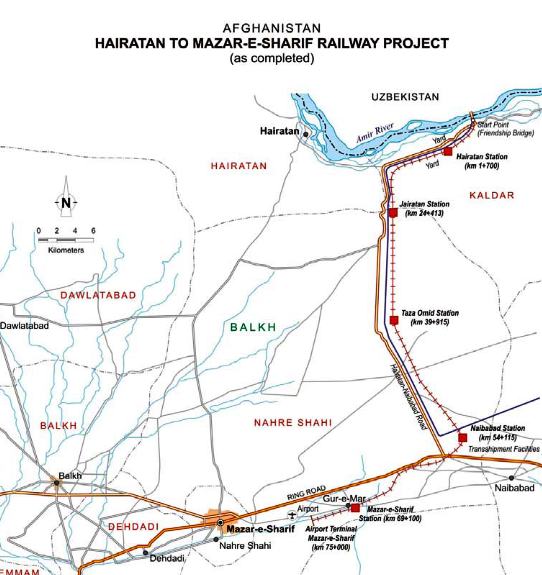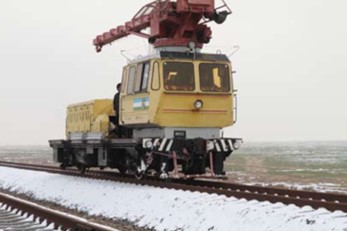nCa Report
This railway segment is just 75km long but it is vital for Afghanistan’s integration with the transportation networks of Central Asia in general and the Middle Corridor in particular.
This railway line runs from Hairatan to Mazar-i-Sharif in Afghanistan and is connected with Uzbekistan at the Termez border point.
 The Hairatan-Mazar (Hairatan-Mazar-i-Sharif) line is the only railway connection between Central Asia and a major economic hub in Afghanistan.
The Hairatan-Mazar (Hairatan-Mazar-i-Sharif) line is the only railway connection between Central Asia and a major economic hub in Afghanistan.
It is a post-soviet creation.
In September 2009, ADB approved a grant for $165 million, with the Government of Afghanistan contributing $5 million. Construction began in January 2010 and was completed by November
2010, significantly ahead of the schedule of engineering, procurement, and construction.
UNSTOPPABLE – The Hairatan to Mazar-e-Sharif Railway Project – Performance-Based Operation and Maintenance Contract
Millions of tons of cargo is transported annually between Afghanistan and Uzbekistan. From the border point with Uzbekistan to the city of Mazar-i-Sharif the cargo reaches within two hours.
The railway track and asocited facilities were in need of reconstruction and overhaul after more than 12 years of extensive use.
Uzbekistan and Afghanistan started the reconstruction work in February this year. The cost of modernization of the Hairatan-Mazar rail track and other infrastructure objects is estimated at USD 6.3 million.
The Afghan Railways Administration (ARA) is confident that the work can be completed within three months.
The Uzbekistan Temir Yollari (Uzbekistan Railways) and ARA have entered into an agreement for this project.
The railroad was built by Uzbekistan Temir Yullari (UTY). Starting from the freight terminal on the Afghanistan bank of the Amu Darya River, the 1,520 mm gauge single-track line runs through relatively easy terrain to the outskirts of Mazar-i-Sharif.
The line is linked via a bridge across the river to Termez, Uzbekistan, and farther on to the modern Uzbekistan rail system. It has a significant economic impact since almost half of Afghanistan’s imports pass through Hairatan.
In addition to putting the rail track, the UTY also built three station buildings, two buildings for passing loops, an automatic signaling system, and a gated automatic level crossing. Operations and maintenance were contracted to Uzbekistan’s Sogdiana Trans for the first 3 years.
Until the opening of the railway, in December 2011, the Hairatan border post was the gateway for almost half of Afghanistan’s imports shipped by road. But as trade and humanitarian relief expanded, it became a bottleneck. The new railway line has quadrupled transport capacity and is boosting regional trade.
At the first stage of the reconstruction work, it is planned to deliver freight cars to the Naibabad station . To this end, comprehensive restoration work will be organized in parallel in Park “B” of the Hairaton station and on the 57th km of the line.
Uzbekistan’s UTY has given 50% discount to Afghanistan on the actual price of the project.
* * *
Afghanistan has three railway connections with Central Asia — Imamnazar-Akina and Kushka-Torgundi with Turkmenistan and Termez-Mazar with Uzbekistan.
The railway links with Turkmenistan are handling a heavy load of food products, fuel products and other items. These links are part of the Lapis Lazuli Corridor (Afghanistan-Turkmenistan-Azerbaijan-Georgia-Türkiye).
The Termez-Mazar link has a special significance because it goes right up to a major economic centre in Afghanistan.
By connecting Mazar-i-Sharif to the railway system of Uzbekistan, the cargo gets access to the Middle Corridor via Kazakhstan.
Moreover, the cargo, when on the Uzbek railway network, also has the options to move through the Uzbek-Turkmen-Iranian-Turkish or Uzbek-Kazakh-Russian routes to reach any destination in Eurasia. /// nCa, 4 March 2024 [some passages from ADB, Gazeta.uz and Kun.uz – images credit ADV and Kun.uz]

